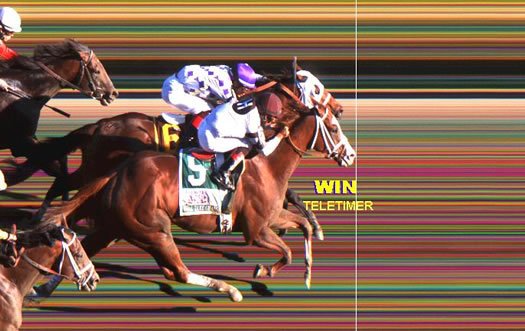
Prior to 1937 race tracks placed 3 stewards at the finish line so when two+ horses crossed the wire together, they would look at each other and vote on who won. Obviously, this inexact science created arguments, and controversy, especially in big money races. Can you imagine today if a million dollar Pick 6 was decided by three judges?
This all changed in 1937 when Bing Crosby unveiled the Del Mar Thoroughbred Club. Bing wanted to do things differently. We know he enlisted all of his Hollywood boys to add a little panache (and of course help finance and build the race track) to the new race meeting. He also did something that changed horse racing forever. He brought in Paramount Pictures motion picture engineer Lorenzo Del Riccio, who had just recently created a new circular flow camera. This new device started the film when an object – in this case a horse’s nose – hit a specific point and began filming in the opposite direction. The famous instrument was used for the first time on opening day at Del Mar in 1937.
As you can imagine this was revolutionary to the world of thoroughbred horse racing and tracks across the country called Del Riccio who was more than willing to sell them the newly patented camera. Hollywood lore has it that when Del Riccio created the camera he was under an exclusive contract with Paramount Pictures and the story goes Paramount began chasing him from town to town until a deal was reached.
How it works is technical. The circular flow camera uses a single vertical slit instead of a shutter; a strip of film moves horizontally across the fine vertical opening located in the focal plane. This limits the field of vision to no more than a few inches, the restricted field being aligned with the vertical line on the winning post on which the lens was focused. The strip film moved across the slit in the opposite direction to the race and at substantially the same speed as the rate of movement of the image of the horses as it passed the finishing line. This kept the image of the horses stationary with respect to the film. As soon as the first horse started to pass over the line, the camera began to record its image on the moving film from the nose backwards along the length of the body in succession. This produced a strip photographic record of the horses as they passed the vertical plane/winning post. Film was advanced continuously at a pace equivalent to the average speed of a racing horse, resulting in distortions of length but still preserving the order of finishers.
Improvements were developed to Del Ricco’s invention in 1948 by Australian Bertram Pearl whose system incorporated a mirror and neon-pulse time signature in the winning-post which would provide a precisely aligned image in which both sides of the horses could be viewed, and on which the neon left a set of stripes at 100th/sec intervals for accurate timing. If the reflected image of the horses aligned vertically exactly with the foreground image, it was proof that the camera was not viewing the finish-line at an angle (and therefore incorrectly recording the horses’ relative positions). Pearl’s partner was his friend, society portraitist Athol Shmith and his contribution was to formulate means to speed the processing of the strip of negative down to 55 seconds and then to a rapid 35 seconds.
Although digital cameras are now used for photo finishes, the technology developed by Del Riccio was instrumental in reassuring gamblers they were betting on fair outcomes, and helped bring horse racing maintain its popularity in American culture.
{{cta(‘7f90c40d-053f-4143-b319-a06be60edf5d’)}}
